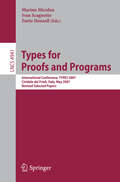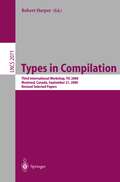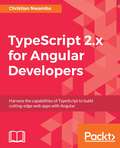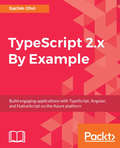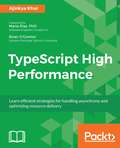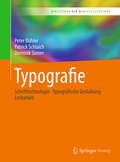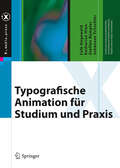- Table View
- List View
Types for Proofs and Programs: International Conference, TYPES 2007, Cividale del Friuli, Italy, May 2-5, 2007, Revised Selected Papers (Lecture Notes in Computer Science #4941)
by Marino Miculan Ivan Scagnetto Furio HonsellThis book constitutes the thoroughly refereed post-conference proceedings of TYPES 2007, the concluding conference of the Types project, held in Cividale del Friuli, Italy, in May 2007. The 13 revised full papers presented were carefully reviewed and selected from 22 submissions. The topic of this last annual workshop of the Types Working Group was formal reasoning and computer programming based on type theory. Great importance was attached to languages and computerized tools for reasoning, and applications in several domains such as analysis of programming languages, certified software, formalization of mathematics and mathematics education.
Types in Compilation: Third International Workshop, TIC 2000, Montreal, Canada, September 21, 2000. Revised Selected Papers (Lecture Notes in Computer Science #2071)
by Robert HarperThe importance of typed languages for building robust software systems is, by now, an undisputed fact. Years of research have led to languages with richly expressive, yet easy to use, type systems for high-level programming languages. Types provide not only a conceptual framework for language designers, but also a ord positive bene ts to the programmer, principally the ability to express and enforce levels of abstraction within a program. Early compilers for typed languages followed closely the methods used for their untyped counterparts. The role of types was limited to the earliest s- ges of compilation, and they were thereafter ignored during the remainder of the translation process. More recently, however, implementors have come to - cognize the importance of types during compilation and even for object code. Several advantages of types in compilation have been noted to date: { They support self-checking by the compiler. By tracking types during c- pilation it is possible for an internal type checker to detect translation errors at an early stage, greatly facilitating compiler development. { They support certi cation of object code. By extending types to the ge- rated object code, it becomes possible for a code user to ensure the basic integrity of that code by checking its type consistency before execution. { They support optimized data representations and calling conventions, even in the presence of modularity. By passing types at compile-, link-, and even run-time, it is possible to avoid compromises of data representation imposed by untyped compilation techniques.
TypeScript 2 for Angular Developers
by Christian NwambaTypeScript, a superset of JavaScript, is the default language for building Angular applications from Google. TypeScript 2.0 adds optional static types, classes, and modules to JavaScript, to enable great tooling and better structuring of large JavaScript applications. This book will teach you how to leverage the exciting features of TypeScript while working on Angular projects to build scalable, data-intensive web applications. You will begin by setting up and installing TypeScript and then compile it with JavaScript. You will then learn to write simple JavaScript expressions with TypeScript. You will then go through some built in TypeScript types and accessors. Further you will build web components using TypeScript Interfaces and Decorators. You will go through the Angular form module, which will enable you to write predictable typed forms with TypeScript and learn to use typed DOM events. You will also build a single-page application using the Router module. Lastly, you will consume API data with Angular's HTTP Module and handle responses with RxJS observables. At the end of the book, you will go through different testing and debugging techniques. What you will learn Move from loose types to predictable strict types Write self-documented API methods and data structures Understand custom generic types for complex data structures Implement Contract with Interfaces Enhance Dependency Injection in Angular via class constructors Explore TypeScript advanced types Build Interactive web apps with Angular and TypeScript Who This Book Is For This book is for developers who would like to learn to use TypeScript to develop Angular applications. A basic JavaScript knowledge would be beneficial.
TypeScript 2.x By Example: Build Engaging Applications With Typescript, Angular, And Nativescript On The Azure Platform
by Sachin OhriThe TypeScript language, compiler, and open source development toolset brings JavaScript development up to the enterprise level. It allows you to use ES5, ES6, and ES7 JavaScript language features today, including classes, interfaces, generics, modules, and more. Its simple typing syntax enables building large, robust applications using object-oriented techniques and industry-standard design principles. This book aims at teaching you how to get up and running with TypeScript development in the most practical way possible. Taking you through two exciting projects built from scratch, you will learn the basics of TypeScript, before progressing to functions, generics, promises, and callbacks. Then, you’ll get to implement object-oriented programming as well as optimize your applications with effective memory management. You’ll also learn to test and secure your applications, before deploying them. Starting with a basic SPA built using Angular, you will progress on to building, maybe, a Chat application or a cool application. You’ll also learn how to use NativeScript to build a cool mobile application. Each of these applications with be explained in detail, allowing you to grasp the concepts fast. By the end of this book, you will have not only built two amazing projects but you will also have the skills necessary to take your development to the next level. What you will learn Design your first project in Visual Studio Learn about the different data types in TypeScript Create web applications in an object-oriented fashion using TypeScript Build a Trello application using TypeScript's complex features. Explore the tools available in a web application ecosystem to write unit test cases Deploy web applications to cloud and assign resources to the application Who This Book Is For Web developers who would like to learn how to use TypeScript to build amazing applications will benefit from this book. Table of Contents Getting Started with TypeScript Our First Application – Sport News Combinator Sports News Combinator - Adding Features Sports News Combinator - The Final Version Application 2 -- Trello Trello – Adding features Testing Trello Application Build a Chat Application Trello Mobile - Using NativeScript Deploying Sample Trello on the Cloud using Microsoft Azure
TypeScript 3.0 Quick Start Guide: The easiest way to learn TypeScript
by Patrick DesjardinsWork with everything you need to create TypeScript applications Key Features Learn enough about all aspects of TypeScript Answers the questions that new users ask about TypeScript Focus on simple examples and concise explanations Book Description TypeScript is designed for the development of large applications and can be used to develop JavaScript applications for both client-side and server-side execution. This book is the ideal introduction to TypeScript, covering both the basics and the techniques you need to build your own applications. We start by setting up the environment and learning about the build tools that support TypeScript. Then we look at scoping of a variable, and the difference between a undefined variable and a null variable. You will then see the difference between an object, an Object, an object literal, and an object built with a constructor, crucial concepts in understanding TypeScript. You will learn how to make your code more generic to increase the reusability of your classes, functions, and structures, and to reduce the burden of duplicating code. We look at creating definition files to transform the actual JavaScript code to be compatible with TypeScript. By the end of the book, you will have worked with everything you need to develop stunning applications using TypeScript. What you will learn Set up the environment quickly to get started with TypeScript Configure TypeScript with essential configurations that run along your code Structure the code using Types and Interfaces to create objects Demonstrate how to create object-oriented code with TypeScript Abstract code with generics to make the code more reusable Transform the actual JavaScript code to be compatible with TypeScript Who this book is for This book is for JavaScript developers who want to get started with TypeScript for building applications. No previous knowledge of TypeScript is expected.
TypeScript 3.0 Quick Start Guide: The easiest way to learn TypeScript
by Patrick DesjardinsWork with everything you need to create TypeScript applications Key Features Learn enough about all aspects of TypeScript Answers the questions that new users ask about TypeScript Focus on simple examples and concise explanations Book Description TypeScript is designed for the development of large applications and can be used to develop JavaScript applications for both client-side and server-side execution. This book is the ideal introduction to TypeScript, covering both the basics and the techniques you need to build your own applications. We start by setting up the environment and learning about the build tools that support TypeScript. Then we look at scoping of a variable, and the difference between a undefined variable and a null variable. You will then see the difference between an object, an Object, an object literal, and an object built with a constructor, crucial concepts in understanding TypeScript. You will learn how to make your code more generic to increase the reusability of your classes, functions, and structures, and to reduce the burden of duplicating code. We look at creating definition files to transform the actual JavaScript code to be compatible with TypeScript. By the end of the book, you will have worked with everything you need to develop stunning applications using TypeScript. What you will learn Set up the environment quickly to get started with TypeScript Configure TypeScript with essential configurations that run along your code Structure the code using Types and Interfaces to create objects Demonstrate how to create object-oriented code with TypeScript Abstract code with generics to make the code more reusable Transform the actual JavaScript code to be compatible with TypeScript Who this book is for This book is for JavaScript developers who want to get started with TypeScript for building applications. No previous knowledge of TypeScript is expected.
TypeScript 3.0 Quick Start Guide: The Easiest Way To Learn Typescript
by Patrick DesjardinsTypeScript is designed for development of large applications and can be used to develop JavaScript applications for both client-side and server-side execution. This book is the ideal introduction to TypeScript, covering both the basics and the techniques you need to build your own applications.
TypeScript Basics: Learn TypeScript from Scratch and Solidify Your Skills with Projects
by Nabendu BiswasJumpstart your working knowledge of Typescript with a quick, practical guide and start using this open source, object orientated language with confidence. This book highlights how Typescript works with JavaScript and its frameworks, giving it greater functionality, especially for larger enterprise projects. You'll start by reviewing some fundamentals such as how to run a TypeScript file and compile it to JavaScript as well as understand how it sits within the full ecosystem alongside React, Redux, Angular and Webpack. Using a practical project-led approach, you'll go through key concepts and aspects of Typescript such as compilers, arrays, classes and interfaces. Once you complete the fundamental basics, you'll move onto more complex topics like advanced types. You'll also learn about Decorators, which are a must-have feature in Angular. The book then presents a small To-do list project followed by a larger 'Drag and Drop' project. You'll see how to divide the drag and drop project into small manageable modules and learn to make the project more efficient with Webpack. Lastly, you'll create two more React projects, a party app with React and then one with React and Redux. Typescript Basics reveals how this JavaScript extension is currently the fastest growing language for web development with more and more developers and companies looking to utilize and adopt it within their current workflows and projects. What You'll LearnUnderstand the particulars of Typescript and how it feeds into the JS and Web development eco-systemImplement Typescript for enterprise projectsUse Typescript with practical projects and examplesSee how Typescript interacts with major frameworks like React and Angular Who This Book Is ForThose who want to learn about TypeScript and implement it in their Enterprise or hobby projects with React and Angular. Beginners will find it easy to learn the basic concepts and principles to get started and to progress onto more advanced projects and how to implement them.
TypeScript Essentials
by Christopher NanceThe book introduces the TypeScript language and its features to anyone looking to develop rich web applications. Whether you are new to web development or are an experienced engineer with strong JavaScript skills, this book will get you writing code quickly. A basic understanding of JavaScript and its language features are necessary for this book.
TypeScript for Beginners: The Ultimate Guide (The Ultimate Guide)
by Sufyan bin UzayrOf late, TypeScript has risen in popularity owing to its ease of use and versatile compatibility. As such, more and more developers are looking to quickly and efficiently master TypeScript. If you’re looking for a detailed, yet easy to comprehend guide to TypeScript, your search ends here! The book is a detailed guide that will help learners get started with TypeScript programming in no time. It talks about the basics and then moves on to practical exercises to help readers quickly gain the required knowledge. The book is meant for both JavaScript developers and learners without a formal JS background. Furthermore, while a background in JavaScript programming might be of help, the book requires no prior coding background and can be easily mastered even by beginners. What Will You Learn: Detailed focus on TypeScript programming Introduction to TypeScript concepts and paradigm Introduction to TS architecture and components OOP programming with TS Web development in TypeScript Who Is This Book for: Web developers looking to learn TypeScript; web development beginners; JavaScript developers; and frontend developers. About the Author Sufyan bin Uzayr is a writer, coder, and entrepreneur with more than a decade of experience in the industry. He has authored several books in the past, pertaining to a diverse range of topics, ranging from History to Computers/IT. Sufyan is the Director of Parakozm, a multinational IT company specializing in EdTech solutions. He also runs Zeba Academy, an online learning and teaching vertical with a focus on STEM fields. Sufyan specializes in a wide variety of technologies, such as JavaScript, Dart, WordPress, Drupal, Linux, and Python. He holds multiple degrees, including ones in Management, IT, Literature, and Political Science. Sufyan is a digital nomad, dividing his time between four countries. He has lived and taught in universities and educational institutions around the globe. Sufyan takes a keen interest in technology, politics, literature, history, and sports, and in his spare time, he enjoys teaching coding and English to young students. Learn more at sufyanism.com
TypeScript for Beginners: The Ultimate Guide (The Ultimate Guide)
by Sufyan bin UzayrOf late, TypeScript has risen in popularity owing to its ease of use and versatile compatibility. As such, more and more developers are looking to quickly and efficiently master TypeScript. If you’re looking for a detailed, yet easy to comprehend guide to TypeScript, your search ends here! The book is a detailed guide that will help learners get started with TypeScript programming in no time. It talks about the basics and then moves on to practical exercises to help readers quickly gain the required knowledge. The book is meant for both JavaScript developers and learners without a formal JS background. Furthermore, while a background in JavaScript programming might be of help, the book requires no prior coding background and can be easily mastered even by beginners. What Will You Learn: Detailed focus on TypeScript programming Introduction to TypeScript concepts and paradigm Introduction to TS architecture and components OOP programming with TS Web development in TypeScript Who Is This Book for: Web developers looking to learn TypeScript; web development beginners; JavaScript developers; and frontend developers. About the Author Sufyan bin Uzayr is a writer, coder, and entrepreneur with more than a decade of experience in the industry. He has authored several books in the past, pertaining to a diverse range of topics, ranging from History to Computers/IT. Sufyan is the Director of Parakozm, a multinational IT company specializing in EdTech solutions. He also runs Zeba Academy, an online learning and teaching vertical with a focus on STEM fields. Sufyan specializes in a wide variety of technologies, such as JavaScript, Dart, WordPress, Drupal, Linux, and Python. He holds multiple degrees, including ones in Management, IT, Literature, and Political Science. Sufyan is a digital nomad, dividing his time between four countries. He has lived and taught in universities and educational institutions around the globe. Sufyan takes a keen interest in technology, politics, literature, history, and sports, and in his spare time, he enjoys teaching coding and English to young students. Learn more at sufyanism.com
TypeScript High Performance
by Ajinkya KherGet lightning speed performance by writing highly efficient code in TypeScript About This Book • Efficiently use Data Structures, Language Constructs, & Handle Asynchrony • Monitor the performance, Code Quality, & Resource Optimizations • Build & Deploy Strategies for Large Scale TypeScript Projects Who This Book Is For This book is for people who have basic knowledge of TypeScript. Experience using JavaScript and familiarity with front end development are the prerequisites. What You Will Learn • Learn about the critical rendering path, and the performance metrics involved along the same • Explore the detailed inner intricacies of a web browser • Build a large scale front end applications and learn the thought process behind architecting such an effort • Understand the challenges of scalability and how TypeScript renders itself to the cause • Learn efficient usage of TypeScript constructs to deliver high performance and avoid common mistakes and pitfalls that can hamper performance • Monitor performance, resolve and detect performance bottlenecks in production, and learn the tools involved In Detail In a world where a tiny decrease in frames per second impacts customer engagement greatly, writing highly scalable code is more of a necessity than a luxury. Using TypeScript you get type checking during development. This gives you the power to write optimized code quickly. This book is also a solid tool to those who're curious to understand the impact of performance in production, and it is of the greatest aid to the proactive developers who like to be cognizant of and avoid the classic pitfalls while coding. The book will starts with explaining the efficient implementation of basic data Structures, data types, and flow control. You will then learn efficient use of advanced language constructs and asynchronous programming. Further, you'll learn different configurations available with TSLint to improve code quality and performance. Next, we'll introduce you to the concepts of profiling and then we deep dive into profiling JS with several tools such as firebug, chrome, fiddler. Finally, you'll learn techniques to build and deploy real world large scale TypeScript applications. Style and approach This book will be a step by step easy to follow guide with focused examples to increase performance of applications and provide optimization techniques.
TypeScript Microservices: Build, deploy, and secure Microservices using TypeScript combined with Node.js
by Parth GhiyaBuild robust microservice-based applications that are distributed, fault tolerant, and always availableAbout This BookLearn to build message-driven services for effective communicationDesign microservices API using Reactive programming design patternsDeploy, scale and monitor microservices for consistent high performanceWho This Book Is ForThis book is for JavaScript developers seeking to utilize their Node.js and Typescript skills to build microservices and move away from the monolithic architecture. Prior knowledge of TypeScript and Node.js is assumed.What You Will LearnGet acquainted with the fundamentals behind microservices.Explore the behavioral changes needed for moving from monolithic to microservices.Dive into reactive programming, Typescript and Node.js to learn its fundamentals in microservicesUnderstand and design a service gateway and service registry for your microservices.Maintain the state of microservice and handle dependencies.Perfect your microservice with unit testing and Integration testingDevelop a microservice, secure it, deploy it, and then scale itIn DetailIn the last few years or so, microservices have achieved the rock star status and right now are one of the most tangible solutions in enterprises to make quick, effective, and scalable applications. The apparent rise of Typescript and long evolution from ES5 to ES6 has seen lots of big companies move to ES6 stack. If you want to learn how to leverage the power of microservices to build robust architecture using reactive programming and Typescript in Node.js, then this book is for you.Typescript Microservices is an end-to-end guide that shows you the implementation of microservices from scratch; right from starting the project to hardening and securing your services. We will begin with a brief introduction to microservices before learning to break your monolith applications into microservices. From here, you will learn reactive programming patterns and how to build APIs for microservices. The next set of topics will take you through the microservice architecture with TypeScript and communication between services. Further, you will learn to test and deploy your TypeScript microservices using the latest tools and implement continuous integration. Finally, you will learn to secure and harden your microservice.By the end of the book, you will be able to build production-ready, scalable, and maintainable microservices using Node.js and Typescript.Style and approachThis book will be a step by step easy to follow guide with focused examples for building microservices with Typescript.
TypeScript Microservices: Build, deploy, and secure Microservices using TypeScript combined with Node.js
by Parth GhiyaBuild robust microservice-based applications that are distributed, fault tolerant, and always availableAbout This BookLearn to build message-driven services for effective communicationDesign microservices API using Reactive programming design patternsDeploy, scale and monitor microservices for consistent high performanceWho This Book Is ForThis book is for JavaScript developers seeking to utilize their Node.js and Typescript skills to build microservices and move away from the monolithic architecture. Prior knowledge of TypeScript and Node.js is assumed.What You Will LearnGet acquainted with the fundamentals behind microservices.Explore the behavioral changes needed for moving from monolithic to microservices.Dive into reactive programming, Typescript and Node.js to learn its fundamentals in microservicesUnderstand and design a service gateway and service registry for your microservices.Maintain the state of microservice and handle dependencies.Perfect your microservice with unit testing and Integration testingDevelop a microservice, secure it, deploy it, and then scale itIn DetailIn the last few years or so, microservices have achieved the rock star status and right now are one of the most tangible solutions in enterprises to make quick, effective, and scalable applications. The apparent rise of Typescript and long evolution from ES5 to ES6 has seen lots of big companies move to ES6 stack. If you want to learn how to leverage the power of microservices to build robust architecture using reactive programming and Typescript in Node.js, then this book is for you.Typescript Microservices is an end-to-end guide that shows you the implementation of microservices from scratch; right from starting the project to hardening and securing your services. We will begin with a brief introduction to microservices before learning to break your monolith applications into microservices. From here, you will learn reactive programming patterns and how to build APIs for microservices. The next set of topics will take you through the microservice architecture with TypeScript and communication between services. Further, you will learn to test and deploy your TypeScript microservices using the latest tools and implement continuous integration. Finally, you will learn to secure and harden your microservice.By the end of the book, you will be able to build production-ready, scalable, and maintainable microservices using Node.js and Typescript.Style and approachThis book will be a step by step easy to follow guide with focused examples for building microservices with Typescript.
TypeScript Microservices: Build, Deploy, And Secure Microservices Using Typescript Combined With Node. Js
by Parth GhiyaMicroservices has evolved as one of the most tangible solutions to make effective and scalable applications. Due to its evolution from ES5 to ES6 stack, Typescript has become one of the most de facto solutions. This book will help you leverage microservices’ power to build robust architecture using reactive programming and Typescript in Node.js.
TypeScript Revealed
by Dan MaharryTypeScript Revealed is a quick 100-page guide to Anders Hejlsberg's new take on JavaScript. With this brief, fast-paced introduction to TypeScript, .NET, Web and Windows 8 application developers who are already familiar with JavaScript will easily get up to speed with TypeScript and decide whether or not to start incorporating it into their own development. TypeScript is &‘JavaScript for Application-scale development&’; a superset of JavaScript that brings to it an additional object-oriented-like syntax familiar to .NET programmers that compiles down into simple, clean JavaScript that any browser can run today. It&’s also tied to the next version of the JavaScript standard, which means that TypeScript will continue to evolve over time to keep in step with that standard and with the capabilities of the engines that will execute JavaScript applications. If you are a .NET developer, Web designer or developer, or a programmer with a keen interest in scalable applications, TypeScript Revealed is a great way to get started with the language, learn how it compiles into JavaScript, and how easy it is to learn from a .NET/Java developer's perspective.Takes you through the language features in Typescript additional to those in JavaScript Describes the tooling and community support for TypeScript development Discusses how TypeScript can be included in ASP.NET, Windows 8, and node.js application development projects.
TYPO3 4.2 E-Commerce: Design, Build, And Profit From A Sophisticated Feature-rich Online Store Using Typo3
by Edgars Karlsons Inese LiberteThis is a fast-paced tutorial focusing on creating an online store. It walks in detail through development of a sample website, illustrating each step with screenshots and explanation. The cumbersome and time-consuming task of developing and customizing a TYPO3 e-commerce site will be a smooth sail with this book. If you want to create a captivating online shop using TYPO3 and optimize your profit, this book is for you. Some knowledge of TYPO3, PHP, and TypoScript is required.
TYPO3 4.3 Multimedia Cookbook: Over 50 Great Recipes For Effectively Managing Multimedia Content To Create An Organized Website In Typo3
by Dan OsipovThe TYPO3 Multimedia Cookbook presents over 50 effective recipes for managing multimedia in your TYPO3 site. Each recipe comprises step-by-step instructions followed by the analysis of what was done in each task and any relevant information. The book is designed so that you can refer to it chapter by chapter, or you can look at the list of recipes and read them in no particular order. The book has recipes to tackle specific problems along with detailed explanations that will help you to customize the recipes as per your individual needs. Since learning comes from doing, the reader is encouraged to follow along with the examples using the book as a practical guide. This book is for anyone who is looking for effective systems for managing multimedia content. You will find this book interesting if you are running, or starting, web sites rich in multimedia content. This book assumes some prior knowledge about TYPO3, which is available either from official documentation, or other books on this topic.
TYPO3 Extension Development: Developer's Guide To Creating Feature-rich Extensions Using The Typo3 Api
by Dmitry DulepovThe book is structured so that following the chapters in order builds a TYPO3 extension from the ground up. Experienced developers can use individual chapters independently to get only the information that they need. Each chapter is divided so that the first part contains a description and discussion of the topic covered followed by a coding example with explanation of how principles and techniques from the first part are followed in the code. The reader is encouraged not only to read the book but also to look into the discussed classes and actually code the extension while reading the book. This book is for PHP developers who want to develop a TYPO3 extension. It assumes the reader has experience with PHP, XML, and HTML. No prior knowledge about TYPO3 extension programming or the TYPO3 API is presumed.
The TYPO3 Guidebook: Understand and Use TYPO3 CMS
by Felicity Brand Heather McNamee Jeffrey A. McGuireLearn how to make the most of TYPO3 – the enterprise CMS – to organize information and digital assets, and communicate globally with powerful multi-site and multilingual support. This book will show you how the TYPO3 CMS backend and frontend work from top to bottom. Content management is a core aspect of every company’s communications, whether intranets and internal digital asset repositories or public-facing product pages and online communities. The book starts with four chapters covering how TYPO3 works, giving you a high-level overview of the most important aspects you should know about, including its community and professional ecosystem. If you’ve never seen TYPO3 before, you’ll learn how to make the most of it and what makes TYPO3 different from other content management systems you may have used before. You'll then move on to 10 hands-on guides. These step-by-step tutorials show you how to work with TYPO3 CMS. Each guide is self-contained, introducing a scenario, and showing you how to solve a given problem. The guides include references to documentation, examples, code samples, and everything you need to get the job done. The TYPO3 Guidebook will help you learn how to put your creative ideas online with TYPO3. What You'll Learn Scope, plan, design, and build efficient websites and web applications with TYPO3Determine how TYPO3 can work best for you and how to avoid complicationsImplement a project from idea to launchManage client expectations and complete TYPO3 projects on time and within budgetUnderstand TYPO3 terminology in practical termsCreate TYPO3 projects using best practices and configure them efficientlyBuild integrations and features using TYPO3 Core APIs Who This Book is For Decision makers, project managers, consultants and developers
TYPO3 Templates
by Jeremy GreenawaltThis book uses a clear, conversational style to teach everything from the simple to the complex in an easy-to-read narrative. The entire book goes through one complete example project to build a company website, and each chapter adds functionality to the final product as the readers learns about the concepts. Every concept and technique is reinforced with working example code, and illustrations and screenshots are used to explain even further when necessary. If you are a developer, designer, or a site builder who wants to get the most out of TYPO3 whether you are building multiple websites for clients or optimizing their company's site then this book is for you. It is written for new or experienced users at all levels, but some basic experience with TYPO3 editing and installation is expected.
Typografie: Schrifttechnologie - Typografische Gestaltung - Lesbarkeit (Bibliothek der Mediengestaltung)
by Peter Bühler Patrick Schlaich Dominik SinnerDieser Band der „Bibliothek der Mediengestaltung“ behandelt die Schrifterkennung und Schriftklassifikation, die Lesbarkeit von Schrift und den gestalterischen und technischen Einsatz von Schriften. Außerdem werden die Schrifttechnologie und die Verwaltung von Schriften thematisiert. Für diese Bibliothek wurden die Themen des Kompendiums der Mediengestaltung neu strukturiert, vollständig überarbeitet und in ein handliches Format gebracht. Leitlinien waren hierbei die Anpassung an die Entwicklungen in der Werbe- und Medienbranche sowie die Berücksichtigung der aktuellen Rahmenpläne und Studienordnungen sowie Prüfungsanforderungen der Ausbildungs- und Studiengänge.Die Bände der „Bibliothek der Mediengestaltung“ enthalten zahlreiche praxisorientierte Aufgaben mit Musterlösungen und eignen sich als Lehr- und Arbeitsbücher an Schulen sowie Hochschulen und zum Selbststudium.
Typografie kompakt: Vom richtigen Umgang mit Schrift am Computer (X.media.press)
by Max BollwageEin schneller Kompaktkurs für alle, die am Computer Texte bearbeiten und Drucksachen gestalten. Knapp und anschaulich, mit Gestaltungsmodellen von der Einladung bis zum Magazin und einem neuen Ordnungssystem für Schriften, das den Überblick erleichtert.
Typografie kompakt: Vom richtigen Umgang mit Schrift am Computer (X.media.press)
by Max Bollwage"Learning by doing", klappt das wirklich immer? Zumindest für die professionelle Textgestaltung am Bildschirm sind ein paar Grundkenntnisse der Typografie unerlässlich. Dieses Buch vermittelt typografisches Basiswissen auf knappe und anschauliche Weise. Es bietet Hilfe für alle, die am Computer Texte bearbeiten, Internetseiten entwerfen und Drucksachen gestalten wollen. Es ist praxisgerecht aufgebaut aus Antworten auf Fragen, die der Computer stellt nach Format, Satzspiegel, Schrift, Schriftgröße, Abstände, Gliederung u.a.m. Keine langen Beschreibungen, dafür leicht merkfähige Abbildungen und in der Praxis erprobte Gestaltungsmodelle. Ein Kapitel befasst sich ausführlich mit der Rolle der Typografie im Corporate Design. Für die heute fast unübersehbare Zahl von Schriften bietet das Buch ein neues Ordnungssystem, das den Überblick über die Schriften erleichtert und hilft, eine passende Schrift zu finden.
Typografische Animation für Studium und Praxis (X.media.press)
by Falk Hegewald Katharina Hien Steffen Rümpler Johannes TritschlerTypografische Animationen werden sehr häufig in Banner-Werbung im Internet genutzt, auf Webseiten, für Werbefilme sowie für Filmtrailer,-abspänne und -ankündigungen in Kino und TV. Das anvisierte Buch bietet neben den Grundlagen von typografischen Animationen eine ausführliche Sammlung mit Screenshots und Anleitungen zu typischen, anspruchsvollen Beispielen. Es richtet sich an aktive Designerinnen und Designer und an Studierende im Design-Bereich, die sich in das Thema einarbeiten wollen. Die Anleitungen des Buches sollen es auch Quereinsteigern ermöglichen, sich effektiv in die Materie einzuarbeiten. Der grundlegende Umgang mit den "gängigen" Design-Programmen wird jedoch vorausgesetzt. Die Gliederung richtet sich nach häufig genutzten Animations-Programmen. Jedes der genutzten Softwareprodukte gibt eine bestimmte ästhetische und funktionale Ausrichtung vor (2-D, 3-D, interaktiv).
